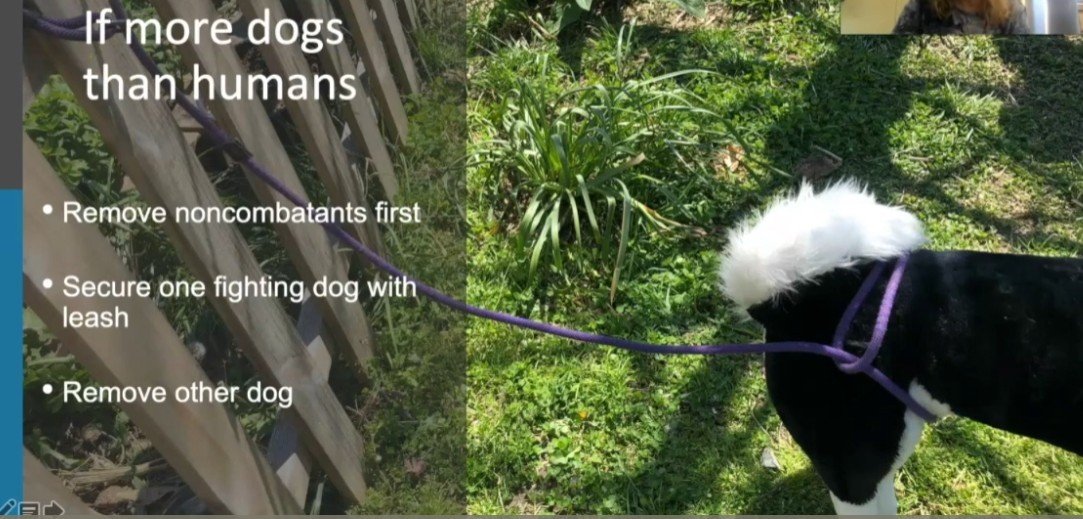How to break up a dog fight
How to break up a dog fight
Jamie Flanders CDBC FPPE CFDM CBC
Coordinate, make sure both of you know what to do and where all the tools are that you might need.
There are two types of dog fights, slash and dash where they bite and release, and grippers where they hold on and may shake their head. There are hands off strategies and there are hands on strategies.
If there is only one of you present, try to determine who the aggressor is and go for her first. If you don’t know who the aggressor is, just pick one.
Do what you have to do, but it’s a good idea to have a plan and understand your options and understand the things to avoid doing. If possible avoid:
Grabbing collars - necks are a typical place for dogs to bite.
Hit, punch, kick - adding pain may make the dog grip harder or get more frenzied.
Put your hands near their mouth.
Put your body between the dogs.
Dangle one in the air - the other may leap up and bite/grab and then gravity brings them down tearing the other dog's skin.
Keep in mind that you have time. It’s okay to go grab your tools before intervening. The exception to this would be if the airway or blood flow is blocked.
When you live with multiple dogs, or when you take your dog out into public where other dogs may be, there is always a potential for dogs to get into conflict or fight. At home with your own group of dogs, if you understand MRANT, tension and conflict zones (forced proximity), arrange the environment to be as open as possible and control the traffic of your group of dogs in specific ways such as pet gates, station training, and practice training multiple dogs at once, then you can reduce the risk of fights greatly.
Here is a post from my website about how to avoid conflicts with other dogs while out and about in public places.
Hands off strategies
There is no guarantee that the strategies you choose will work, so it’s good to know many strategies that you can try.
Have leashes available in an easy access place so that you can gain control of them and separate for hands off, hands on, and out and about. Since you don’t want to put your hands near their neck and face you can use a leash to quickly wrap around their waist and secure them to something, see image for example. Loop the end of the leash through the handle hole.
Image from Trish McMillan Animal Behavior
Water
Hose if outside.
Dumping a bowl of water on them if inside.
A squirt bottle - can be taken on walks.
A bottle of water - on walks
Noise makers
Air horn - have one in an easy to get to location in your home, carry one on your body when out in public around unfamiliar dogs. This can be used as a deterrent to an off leash dog approaching as well.
Keep in mind that if you are using noise deterrents for off leash dog encounters, noise makers will affect your dogs as well. I can not use noise makers as a strategy when out and about because my dog is very sensitive to sound and you need to think about how your dog will cope with this encounter mentally when it’s over. If I scare my dog with a loud noise while he’s being attacked by another dog, I may create a bigger problem with him becoming wary and scared of other dogs in the future.
Pet corrector - a very loud hissing can of compressed air. Have one in an easy to get to location in your home, carry one on your body when out in public around unfamiliar dogs. This can be used as a deterrent to an off leash dog approaching as well.
Bang pots and pans together - home strategy
Yell - avoid screaming, use a low growly tone loud in volume, men are naturally equipped for this.
Sprays - avoid fogging sprays like mace, this will affect you and your dogs. Sprays are more appropriate for outside and can be used as a deterrent for off leash dogs rushing or when dogs are getting tense. Sprays can be used to break up a fight. Spray it in front of the nose first, if that doesn’t work spray in the mouth.
Halt spray - a pepper spray that streams out 10-12 feet, it does not puff out so you should not be affected.
Spray shield - a citronella spray that streams up to 10 feet.
Vision blocks - push the vision blocker between the dogs and use it to corral one away behind a permanent barrier like in another room with the door closed.
Umbrella - umbrellas can be used as a startle deterrent if it’s an auto open that deploys before the other dog reaches you. Umbrellas can also be used as a vision blocker.
Chair
Trash can
Doors
Blankets
Jackets
Towel
Hands on strategies
Again remember that using hands on strategies could get you bitten.
Image from Trish McMillan Animal Behavior
Image from Trish McMillan Animal Behavior
Image from Trish McMillan Animal Behavior
Wheel barrow - Grab their waist in front of their hips. Grip them and pull their back legs up in the air. It might cause a dog gripping dog to let go but it’s better for slash and dash fights. Because after you wheelbarrow you need to pull the dog away.
Get into control position - stand over the dog, pin their waist between your legs, hold the collar or grab scruff. Another person tries to gain control of the other dog.
Feed the bite - This is for gripping fights. Get into control position, grab the collar or scruff, another person stabilizes the other dog. Line the biting dog up at a 90 degree angle and push the gripping dog into the dog it’s biting, this fills the mouth and loosens the grip. Remove them from each other when the dog releases its grip. Don’t pull them apart if one of them is gripping the other, this will cause more severe damage.
Bite stick - A break stick is used to pry open the mouth of a dog that is grip biting another dog. Get control position first, push the breakstick in the open hole behind their canine teeth, twist until the dog releases. Then quickly remove the dogs from sight of each other.




